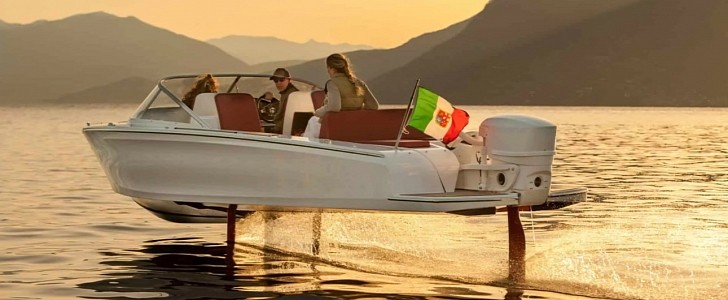Since summer is here, hydrofoils are already spiking up in sales all over the world. This "flying boat" from Swedish boat-builder Candela is already making waves with barely touching the water. So if you want to have the best of both worlds, this is going to be right up your alley, or dock in this case.
Dubbed C-7, the electric boat has been gliding over the Caribbean Archipelago and Austrian lakes since last year. Introduced by Candela as the "world's first and only electric foiling boat," it claims to pack a greater range and higher speed than other conventional e-boats.
Incorporating fully submerged foils, the C-7's computer-controlled system is designed to offer a silent driving experience and a smooth ride, even in choppy conditions. The hull is entirely lifted above the water's surface, reducing friction by 80 percent.
This translates to an increased range of 57 miles (93 km) at a speed of 25 mph (41 kph). While that's not lightning fast, according to Candela, it's still about three times the range of other electric boats on the market.
Its top speed can reach 35 mph (56 kph) on a single charge of its 40 kWh lithium battery pack from BMWi3. That's enough juice for a trip on the entire San Francisco Bay. With a wake of only 5 cm (2-in) high, the waves produced will not impact neighboring boats or buildings, even when operating in narrow passages.
C-7 can operate in shallow water because its foils and propulsion unit are retractable. This system also allows for more accessible storage. All controls, including ones for retracting the hydrofoils, are accessible on the 12-inch touchscreen.
Its foils' angle can be automatically adjusted 100 times per second via its digital flight controller that uses ultrasonic sensors, gyroscopes, accelerometers, and GPS to measure the position, speed, and acceleration of the boat. The C-7 can accommodate six passengers on board with running costs up to 95 percent less than an equivalent boat that navigates on fuel.
According to Italian publication Repubblica, the "flying boat" is currently being tested in Venice, Italy. Candela seeks to provide the city with a non-harmful alternative to the thousands of motorboats that cross the canals, causing additional deterioration of the city's buildings.
Incorporating fully submerged foils, the C-7's computer-controlled system is designed to offer a silent driving experience and a smooth ride, even in choppy conditions. The hull is entirely lifted above the water's surface, reducing friction by 80 percent.
This translates to an increased range of 57 miles (93 km) at a speed of 25 mph (41 kph). While that's not lightning fast, according to Candela, it's still about three times the range of other electric boats on the market.
Its top speed can reach 35 mph (56 kph) on a single charge of its 40 kWh lithium battery pack from BMWi3. That's enough juice for a trip on the entire San Francisco Bay. With a wake of only 5 cm (2-in) high, the waves produced will not impact neighboring boats or buildings, even when operating in narrow passages.
C-7 can operate in shallow water because its foils and propulsion unit are retractable. This system also allows for more accessible storage. All controls, including ones for retracting the hydrofoils, are accessible on the 12-inch touchscreen.
Its foils' angle can be automatically adjusted 100 times per second via its digital flight controller that uses ultrasonic sensors, gyroscopes, accelerometers, and GPS to measure the position, speed, and acceleration of the boat. The C-7 can accommodate six passengers on board with running costs up to 95 percent less than an equivalent boat that navigates on fuel.
According to Italian publication Repubblica, the "flying boat" is currently being tested in Venice, Italy. Candela seeks to provide the city with a non-harmful alternative to the thousands of motorboats that cross the canals, causing additional deterioration of the city's buildings.







